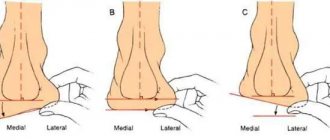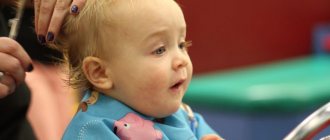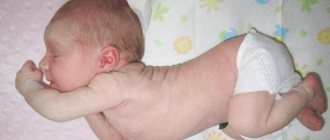Newborn cries and grunts in his sleep
Why does a newborn cry or groan in his sleep? Is he experiencing some discomfort, is he in pain? Young parents do not know what to do in such a situation and anxiously rush to see a doctor. We hasten to reassure you. Everything is fine.
Crying or grunting in your sleep is normal. Research shows that this reaction occurs due to dreams. In addition, babies in this way check if their parents are nearby and instinctively seek your protection and support. And if he doesn’t find her, he starts crying for real. Of course, this requires your intervention.
However, you shouldn't react with excitement every time your newborn starts in his sleep. If you do everything correctly, then over time the child will learn to calm down on his own. Otherwise, he will require excessive care with age. The skill of self-soothing is developed in children during the first year of life. And it is your duty to contribute to this.
Sleeps very restlessly, moans, tosses and turns a lot, fidgets, wriggles, twitches, often wakes up
Restless sleep in an infant can be caused by many factors. Here are some of them:
- REM sleep phase - the baby shudders and twitches in his sleep, because during this period he dreams, moves and processes the events of the past day with his brain. In this phase, the child is very easy to wake up, because sleep is superficial.
- Noise interferes - the child often wakes up if there is loud noise in the immediate environment (TV, conversations, laughter, operation of household appliances, etc.).
- Something hurts - if the baby is bothered by pain in the abdomen, gums or any other part of the body, he fidgets for no apparent reason, twitches and sometimes moans (makes drawn-out sounds). Perhaps he has inflammation of some internal organs, accompanied by high body temperature.
- Uncomfortable position - if a child is placed in a crib in an uncomfortable position, he often tosses and turns a lot. Here are examples of comfortable positions for a newborn: on the side, on the back, on the tummy. But in the case of, for example, hip dysplasia, on the contrary, it is not recommended for him to sleep on his side (due to the load on the joints). And premature babies with congenital neurological diseases should not be placed on their stomachs.
- Temperature conditions - if the room is too hot or, conversely, cool, the baby sleeps restlessly and often wakes up. Therefore, the children's room must have the appropriate temperature and humidity level. It is better to consult a pediatrician on this issue.
- Feelings of insecurity - if the baby has previously slept with mom and is now placed alone in the crib, he may feel insecure and afraid. This causes the baby to often shudder and cry after waking up.
When to ask for help
Now let's look at cases in which your baby needs the help of a specialist. The most widespread insomnia is difficulty falling asleep, as well as regular awakenings. There are the following causes of insomnia in children:
- Secondary – occurs as a consequence of any disease. For example, insomnia in children can occur due to fever or abdominal pain.
- Primary – not associated with any diseases. The main cause of insomnia in children in this case is the behavior of parents or the child during sleep.
Secondary causes of insomnia in children are eliminated by treating the diseases that cause it. Primary – by adjusting behavior patterns during the period of falling asleep. Let's look at how to do this.
The baby's respiratory system in the first weeks after birth
A newborn baby develops very quickly. Human systems and organs grow at an accelerated rate. Therefore, pulse, respiration and blood pressure are always higher than those of an adult. In particular, the child's pulse can be up to 140 beats per minute. The baby's breathing is still shallow, frequent, and uneven. But this should not frighten parents if there are no additional signs of disease.
By the age of 6-7 years, life support systems return to normal, immunity increases, and all diseases are not so difficult to tolerate.
Behavioral insomnia
Incorrect behavioral patterns when falling asleep include:
- falling asleep in your parents' bed or in your arms;
- with a finger in the mouth;
- while eating with a bottle in the mouth.
Most parents will ask, “What's wrong with that?” Everything is very simple. If the baby wakes up and does not find nearby what made him fall asleep, he will begin to demand it. To eliminate insomnia in children, it is necessary to follow the correct behavioral patterns before going to bed. What are they?
It is necessary to follow a certain algorithm for preparing for bed every day. Everything is simple here. Bathing, eating, staying near the crib for a short time and leaving the child alone. Accustoming your baby to this sequence is the key to comfortable sleep. Both for himself and for his parents.
A “subject mediator” will help a child develop the described behavioral model. This is a specific object that is next to the baby during sleep. For infants, this is, for example, a diaper that retains the mother’s scent, and for those who are older, it is a favorite toy. All this gives children a feeling of comfort and suppresses anxiety during awakenings, and also allows them to feel your closeness.
What to do if your child does not want to accept a certain sleep schedule? Every now and then he goes to the toilet, asks for water, or even comes to bed with his parents. Do not put pressure on the child under any circumstances. This will only make the situation worse.
It is necessary to unobtrusively persuade the child to comply with the regime. This will set your baby's brain up for sleep and prepare him for parting with you. So, for example, you can strictly determine the number of fairy tales you read before bed.
Rapid breathing movements of a baby: normal or pathological
The frequency of inhalations and exhalations on the first day is very high, up to 60 movements. This is called transient hyperventilation and helps the baby adapt to life outside the womb.
It is important to know! Fast movements are necessary to remove harmful carbon dioxide. After a short time (several hours), the frequency is up to 40 inhalations and exhalations. This is the norm and does not require correction. Also, intermittency: frequent, rare, weak or with pauses of up to 10 seconds breathing is not considered a deviation.
Jumps and changes are associated with insufficient development of the respiratory nerves, so parents should not worry.
Different types of breathing
So that mom and dad don’t worry about the frequency of movements of the child’s oxygen supply system, you should know about certain types of breathing. There are three of them in total. Let's look at each of them in detail:
- Breast. With such movements, the upper section actively works. In this case, the baby may suffer from poor ventilation of the lower lungs.
- Abdominal. This is evidenced by movements of the abdominal wall and diaphragm. And with prolonged breathing of this type, the upper parts of the lungs suffer.
- Mixed. The most optimal type, in which both the abdomen (diaphragm) and chest rise rhythmically.
Standard Frequency and Deviation Parameters
If the little one does not have a stuffy nose, all systems work normally, he should inhale briefly 2-3 times, and then take one long breath. They are all superficial, but this is the norm. As the weeks pass, the breathing system is restored and becomes rhythmic and deep.
The number of movements can be determined by the rise/fall of the baby’s chest at rest:
- up to 21 days of life takes 40-60 inhalations/exhalations;
- in days 22-90 of life – already 40-45 movements per minute;
- from 3 to 6 months their number decreases to 35-40.
It is important to know! By the age of one year, the body's oxygen supply systems are formed, and the number of respiratory movements should not exceed 36 units per minute.
Frequent breathing: causes
It is normal for a baby to inhale frequently. But if a newborn baby breathes heavily in his sleep, and the process is accompanied by strange sounds and movements, he may be developing a disease. If the baby twitches, breathing is extremely difficult, with wheezing and additional symptoms, this is a reason to immediately consult a doctor. You should call an ambulance.
The causes of difficulty breathing can be anything: a cold, a stuffy nose, a foreign object or mucus in the nasopharynx, an allergic reaction and much more.
Dangerous pathologies and their consequences
Apnea (holding your breath) in an infant is often a natural process. However, there are pathologies that require immediate specialist intervention:
- ARVI. Despite the simplicity of the disease, a cold causes a lot of problems for an infant. The infection spreads with hurricane speed, can quickly move to other parts of the body and cause inflammatory processes. Additional signs: wheezing, sniffling, severe holding of breath.
- Oxygen deficiency. Additional signs: cyanosis of the skin, obvious hypoxia. It’s not just hard to breathe, it’s impossible, the baby begins to gasp for air and may lose consciousness.
- Rise in body temperature. It may appear due to colds and teething.
- False croup. A most dangerous pathology in which delay in calling a doctor threatens death. The child is suffocating and does not move. An ambulance is vital here.
- Bronchial asthma. Threatens serious complications, suffocation.
Attention! An ambulance should be called in the following cases:
- groans, whistling, heavy wheezing;
- cough and runny nose, accompanied by wheezing in the chest;
- gurgling in the throat and nose that does not go away for a long time.
And, of course, you should not delay contacting specialists if the child simply does not breathe for more than 20 seconds. Such a stop could result in death.
When not to panic
Having understood the signs of serious pathologies, you should know that apnea and other factors are not always caused by diseases. In what cases is it better for parents to calm down and independently help the baby breathe normally? Let's consider all the options for a child's frequent breathing without a threat to health and life:
- physical activity;
- excitation;
- cry;
- temporary underdevelopment of the respiratory system;
- accumulation of saliva, which the baby does not swallow in time.
If the baby's sleep is interrupted by stopping breathing for a few seconds, you can take the baby in your arms, cradle him and gently pat him on the back and bottom - everything will go away.
Treatment of insomnia in children
What can you do:
- Create a clear daily routine and meal schedule for your child so that he naturally falls asleep at a certain time.
- Use the baby's crib only for sleeping - do not play or eat in it.
- The use of special drugs that improve sleep is undesirable. They can be used occasionally to adjust the regimen. And then strictly individually, after consultation with a doctor.
For secondary causes of insomnia, treatment is reduced to eliminating the pathology that caused insomnia. To do this, you need to contact your pediatrician. During treatment, he will prescribe sedatives. However, even at the same time, we must not forget about the daily routine, diet and behavioral therapy.
If you are unable to force your child to follow the routine on your own, contact the Seven Doctors multifunctional health clinic in St. Petersburg. To make an appointment, please call 8(812)677-0-777. A professional somnologist will advise you on all your questions and select the most convenient time for your visit.










